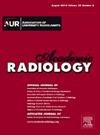Ultrasound-based artificial intelligence model for prediction of Ki-67 proliferation index in soft tissue tumors
IF 3.8
2区 医学
Q1 RADIOLOGY, NUCLEAR MEDICINE & MEDICAL IMAGING
引用次数: 0
Abstract
Rationale and Objectives
To investigate the value of deep learning (DL) combined with radiomics and clinical and imaging features in predicting the Ki-67 proliferation index of soft tissue tumors (STTs).
Materials and Methods
In this retrospective study, a total of 394 patients with STTs admitted from January 2021 to December 2023 in two separate hospitals were collected. Hospital-1 was the training cohort (323 cases, of which 89 and 234 were high and low Ki-67, respectively) and Hospital-2 was the external validation cohort (71 cases, of which 23 and 48 were high and low Ki-67, respectively). Clinical and ultrasound characteristics including age, sex, tumor size, morphology, margins, internal echoes and blood flow were assessed. Risk factors with significant correlations were screened by univariate and multivariate logistic regression analyses. After extracting the radiomics and DL features, the feature fusion model is constructed by Support Vector Machine. The prediction results obtained from separate clinical features, radiomics features and DL features were combined to construct decision fusion models. Finally, the DeLong test was used to compare whether the AUCs between the models were significantly different.
Results
The three feature fusion models and three decision fusion models constructed demonstrated excellent diagnostic performance in predicting Ki-67 expression levels in STTs. Among them, the feature fusion model based on clinical, radiomics, and DL performed the best with an AUC of 0.911 (95% CI: 0.886–0.935) in the training cohort and 0.923 (95% CI: 0.873–0.972) in the validation cohort, and proved to be well-calibrated and clinically useful. The DeLong test showed that the decision fusion models based on clinical, radiomics and DL performed significantly worse than the three feature fusion models on the validation set. There was no statistical difference in diagnostic performance between the other models.
Conclusion
The ultrasound-based fusion model of clinical, radiomics, and DL features showed good performance in predicting Ki-67 expression levels in STTs.
基于超声波的人工智能模型预测软组织肿瘤的 Ki-67 增殖指数
原理与目标研究深度学习(DL)结合放射组学、临床和影像学特征预测软组织肿瘤(STTs)Ki-67增殖指数的价值:在这项回顾性研究中,收集了两家医院从 2021 年 1 月至 2023 年 12 月期间收治的 394 例 STT 患者。医院1为培训队列(323例,其中高Ki-67和低Ki-67分别为89例和234例),医院2为外部验证队列(71例,其中高Ki-67和低Ki-67分别为23例和48例)。对临床和超声特征进行了评估,包括年龄、性别、肿瘤大小、形态、边缘、内部回声和血流。通过单变量和多变量逻辑回归分析筛选出有明显相关性的风险因素。提取放射组学和 DL 特征后,通过支持向量机构建特征融合模型。将分别从临床特征、放射组学特征和 DL 特征中获得的预测结果结合起来,构建决策融合模型。最后,使用 DeLong 检验比较模型之间的 AUC 是否有显著差异:结果:所构建的三种特征融合模型和三种决策融合模型在预测 STT 中 Ki-67 表达水平方面表现出了卓越的诊断性能。其中,基于临床、放射组学和 DL 的特征融合模型表现最佳,训练队列中的 AUC 为 0.911(95% CI:0.886-0.935),验证队列中的 AUC 为 0.923(95% CI:0.873-0.972),证明该模型具有良好的校准性和临床实用性。DeLong 检验表明,在验证集上,基于临床、放射组学和 DL 的决策融合模型的表现明显差于三种特征融合模型。其他模型的诊断性能没有统计学差异:结论:基于超声的临床、放射组学和 DL 特征融合模型在预测 STT 中 Ki-67 表达水平方面表现良好。
本文章由计算机程序翻译,如有差异,请以英文原文为准。
求助全文
约1分钟内获得全文
求助全文
来源期刊

Academic Radiology
医学-核医学
CiteScore
7.60
自引率
10.40%
发文量
432
审稿时长
18 days
期刊介绍:
Academic Radiology publishes original reports of clinical and laboratory investigations in diagnostic imaging, the diagnostic use of radioactive isotopes, computed tomography, positron emission tomography, magnetic resonance imaging, ultrasound, digital subtraction angiography, image-guided interventions and related techniques. It also includes brief technical reports describing original observations, techniques, and instrumental developments; state-of-the-art reports on clinical issues, new technology and other topics of current medical importance; meta-analyses; scientific studies and opinions on radiologic education; and letters to the Editor.
 求助内容:
求助内容: 应助结果提醒方式:
应助结果提醒方式:


